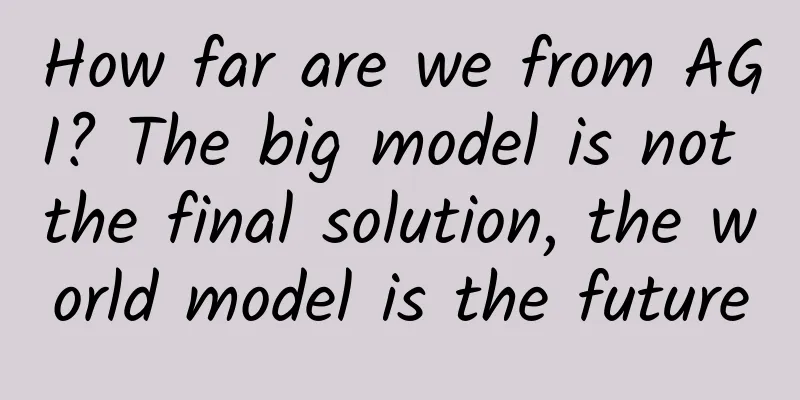How far are we from AGI? The big model is not the final solution, the world model is the future

|
In science fiction movies, AI systems like JARVIS are almost omnipotent and are the ultimate assistants that help humans solve various difficult problems. Behind them is people's pursuit of the most advanced AI, a concept called Artificial General Intelligence (AGI). The concept of AGI can be traced back to the mid-20th century, when many computer scientists and AI researchers began to think about how to build computer programs with human-like intelligence. Unlike narrow AI systems that focus on solving specific tasks, AGI is endowed with broader cognitive and reasoning capabilities, able to learn, adapt and perform tasks in multiple fields. However, for a long time, AI-related research has mainly focused on solving specific problems and tasks, while the realization of AGI has always been considered a more complex and distant goal. Recently, Dr. Valentino Zocca, Vice President of Data Science at Citibank, conducted an in-depth analysis of AGI and other important issues in an article titled "How far are we from AGI?" The core points are as follows: Compared with current narrow artificial intelligence, AGI needs to be able to reason and learn in multiple cognitive fields. However, there are still many challenges in achieving AGI, such as building a world model and performing causal reasoning. Large language models (such as GPT-4) perform well in solving specific tasks and extracting causal relationships, but lack the ability to abstract causal reasoning. They tend to extract known causal patterns from data and cannot generate new causal insights. Some researchers believe that existing large language models (such as GPT-4) may be a step towards AGI, but there are still many unresolved problems, such as creating world models, enabling self-exploration, and performing causal deduction. Large language models are good at identifying and extracting causal relationships from data, but lack the ability to actively infer new causal scenarios on their own. They have the ability to make causal inductions through observations, but not the ability to make causal deductions. AI may not truly “learn” but only refine information or experience. Rather than forming a comprehensive model of the world, AI creates a summary. By using scores as a sign of ability, AI is like seeing only a rough overview of the world without truly understanding the essence of the world as a whole. We should think of intelligence not just as an abstract ability to find solutions to general problems, but as a concrete ability to apply solutions learned from prior experience to different situations that may arise in our environment. Only when we can create a system that can doubt its own reality, conduct self-exploration, and at least apply causal deduction to build a reasonable model of the world, can we truly achieve AGI. Academic Headlines has made a simple translation without changing the original meaning. The content is as follows: About 200,000 years ago, we humans began to walk the Earth, exploring the realms of thought and knowledge. This history was shaped by a series of discoveries and inventions. Some of these not only influenced the course of our history, but also subtly influenced our biology. For example, the discovery of fire gave our ancestors the ability to cook food, thereby transferring heat to the evolution of the brain rather than just the digestive tract, which promoted the advancement of human intelligence. From the invention of the wheel to the birth of the steam engine, mankind ushered in the Industrial Revolution. During this transformation, electricity greatly promoted the technological progress we know as a whole. The printing press accelerated the widespread dissemination of new ideas and new culture, further promoting the pace of innovation. However, human progress does not come only from new material discoveries, it also comes from new ideas. The history of the so-called Western world, from the fall of the Roman Empire to the Middle Ages, experienced a rebirth during the Renaissance and the Enlightenment, which emphasized the centrality of human thought rather than the so-called omnipotent gods. However, as human knowledge progressed, humans began to realize their own insignificance. More than two thousand years after Socrates, humans began to "know that they know nothing", and our earth was no longer seen as the center of the universe. The universe itself is expanding, and we are just a speck of dust in it. Changing your perception of reality Yet the 20th century may be the most controversial century in terms of reshaping our understanding of the world. In 1931, Kurt Gödel published his incompleteness theorems. Just four years later, Einstein, Boris Podolsky, and Nathan Rosen proposed the "EPR paradox" in a paper titled "Can Quantum-Mechanical Description of Physical Reality Be Considered Complete?" on the theme of "completeness." This paper was subsequently refuted by Niels Bohr, who proved the actual validity of quantum physics. Gödel's incompleteness theorem states that even mathematics cannot ultimately prove everything, and we will always face situations where there are facts that cannot be proven. Quantum theory, on the other hand, states that our world lacks determinism, and we cannot predict certain events, such as the speed and position of electrons, despite Einstein's famous position that "God does not play dice." Fundamentally, our limitations extend beyond just predicting or understanding events within the realm of physics. Even if we strive to construct a mathematical universe governed entirely by the rules we conceive, there will still be undeniable facts about this abstract universe. Yet, in addition to mathematical statements, our world is filled with philosophical statements that describe realities that we find ourselves unable to describe, fully express, understand, or even just define. Similar to the uncertainty surrounding the concept of “truth” in the early 20th century, other concepts such as “art,” “beauty,” and “life” also lack fundamental consensus on their definitions. However, these are not isolated cases; other concepts such as “wisdom” and “consciousness” are also in this dilemma. Definition of Intelligence To bridge this gap, Legg and Hutter proposed a definition of intelligence in "Universal Intelligence: A Definition of Machine Intelligence" in 2017: "Intelligence measures the ability of an agent to achieve goals in a variety of environments ." Similarly, in "Problem-Solving and Intelligence", Hambrick, Burgoyne, and Altmann believe that the ability to solve problems is not only an aspect or feature of intelligence, but also the essence of intelligence. The two statements have literal similarities, because achieving goals can be linked to solving problems. Gottfredson summarized the views of several researchers in "An Editorial with 52 Signatories": Intelligence is a very general psychological ability, including reasoning, planning, problem solving, abstract thinking, understanding of complex ideas, rapid learning, and learning from experience. It is not just book knowledge, narrow academic skills, or test-taking skills. Instead, it reflects a broader and deeper ability to understand the surrounding environment. An ability to "grasp" and "understand" things, or "conceive" a way to deal with them. This definition introduces two key dimensions, namely the ability to learn from experience and to understand one’s surroundings, thus taking the concept of intelligence beyond mere “problem-solving skills.” In other words, we should not think of intelligence as just an abstract ability to find solutions to general problems, but rather as a concrete ability to apply solutions learned from prior experience to different situations that may arise in our environment. This highlights the intrinsic connection between intelligence and learning. In "How we learn", Stanislas Dehaene defines learning as "learning is the formation of a model of the world", which means that intelligence also requires the ability to understand our surroundings and build an internal model to describe them. Therefore, intelligence also requires the ability to create a model of the world, even if this ability may not be comprehensive. How smart are today’s machines? When discussing general AGI and narrow AI, we often emphasize the difference between them. Narrow AI (or weak AI) is very common and successful, often outperforming humans on specific tasks. A good example is that in 2016, AlphaGo defeated the then Go world champion Lee Sedol with a score of 4 to 1. However, even so, an event in 2023 highlighted some of the limitations of narrow AI. In the Go game, amateur player Kellin Perline won using tactics that AI did not discover. It can be seen that AI lacks the human ability to recognize uncommon strategies and make corresponding adjustments. In fact, at the most basic level, even inexperienced data scientists can understand that every machine learning model that AI relies on, even the simplest ones, needs to strike a balance between bias and variance. This means that AI needs to learn from data in order to understand and generalize solutions rather than memorize them. Narrow AI uses the computing power and memory capacity of computers to generate complex models based on large amounts of observed data with relative ease. However, these models often fail to generalize once conditions change slightly. It's like we came up with a theory of gravity that works only on Earth based on observations, then discovered that objects are much lighter on the Moon. If we use variables instead of numbers based on our knowledge of gravity theory, we'll understand how to quickly predict the strength of gravity on each planet or moon using the right values. But if we only use numerical equations without symbols, we won't be able to correctly generalize these equations to other celestial bodies without rewriting them. In other words, AI may not truly “learn” but only distill information or experience. Rather than forming a comprehensive model of the world, AI creates a summary . Have we really achieved AGI? The commonly understood definition of AGI is that an AI system can understand and reason at a human level or higher in multiple cognitive domains. This is in stark contrast to current narrow AI systems (such as AlphaGo) that specialize in specific tasks. AGI refers to an AI system that has comprehensive, human-level intelligence that can span different areas of abstract thinking. As mentioned earlier, this requires the ability to create a model of the world that is consistent with experience and allows accurate assumptions to be made about predictions. In line with the views of most AI researchers and pundits, it will take several years to achieve true AGI, although predictions vary as to when it will appear. In the article “AGI Safety Literature Review”, Everitt, Lea, and Hutter mentioned: “We asked a lot of researchers, and they thought AGI might appear between 2040-2061, but the guesses varied widely, from some that it might never appear, to others that it might appear in the next few years.” In short, it is certain that AGI is not with us yet. Microsoft pointed out in its recently published paper “Sparks of Artificial General Intelligence: Early experiments with GPT-4”: "We argue that GPT-4 is part of a new class of LLMs that exhibit more general intelligence than previous AI models. We discuss the growing capabilities and impact of these models. We show that in addition to being proficient in language, GPT-4 can solve novel and difficult tasks in mathematics, coding, vision, medicine, law, psychology, and more, without requiring any special prompts. Moreover, in all of these tasks, GPT-4 performs very close to human levels and often far exceeds previous models such as ChatGPT. Given the power of GPT-4, we think it is reasonable to view it as a near (but still incomplete) version of an artificial general intelligence (AGI) system." What's the problem? Microsoft is a partner of OpenAI. An article in The New York Times quoted Carnegie Mellon professor Maarten Sap as saying: "This is an example of some of these big companies using the research paper format for PR purposes." In an interview with IEEE Spectrum, researcher and robotics entrepreneur Rodney Brooks stressed that we often "mistook performance for capability" when evaluating the capabilities of systems like ChatGPT . To explain it another way, by using scores as a sign of ability, it's as if AI only sees a rough overview of the world without truly understanding the essence of the world as a whole. A major problem AI faces is their training data. Most models are trained only on text, without the ability to speak, hear, smell, or live in the real world. As I mentioned before, this situation is a bit like Plato's allegory of the cave. In that story, people can only see shadows on the cave wall and cannot directly experience the real world. Even if they can create a world model, their world is just a pure text world, syntactically correct but not semantically comprehensive. This environment lacks the "common sense" generated by direct perception, so it seems lackluster. What are the main limitations of large language models? Another of the most controversial challenges facing Large Language Models (LLMs) like ChatGPT or GPT-4 is that they are prone to hallucinations, which are fake quotes and facts that sometimes make no sense, caused by a lack of understanding of cause and effect between events. In “Is ChatGPT a Good Causal Reasoner? A Comprehensive Evaluation”, the authors conclude that “ ChatGPT suffers from a serious problem of causal illusions, and tends to assume causal relationships between events regardless of whether these relationships actually exist ”. They further state that “ChatGPT is not a good causal reasoner, but a good causal explainer”, again highlighting its ability to extract connections when explaining, but not being able to infer these connections by constructing an existing model of the world, where these connections naturally exist. While this post focuses on ChatGPT, it can be extended to any LLMs. Fundamentally, we can see that LLMs are good at identifying and extracting causal relationships from data, but lack the ability to actively infer new causal scenarios on their own . They have the ability to make causal inductions through observations, but not the ability to make causal deductions. This distinction highlights a limitation: the system can identify causal patterns but lacks the ability to make abstract causal inferences. It does not generate new causal insights, but only interprets causal connections from the data. However, if intelligence requires learning from experience, and learning translates into creating a model of the world that we can use to understand our surroundings, then causal deduction constitutes an essential element of learning, and thus of intelligence, an aspect that is missing from existing models . This is one of the key steps in our progress towards AGI. in conclusion As demonstrated in the early 20th century, reality often differs from our intuitions formed by everyday observations. Just as physicists in the early 20th century struggled to understand quantum mechanics because it went against human intuition, the AI systems we build today are constrained to a narrow slice of reality, even narrower than what we humans can experience. Just as we eventually come to understand a reality that contradicts our everyday experience, we will only truly achieve AGI when we can create a system that can doubt its own reality, conduct self-exploration, and at least apply causal deduction to build a reasonable model of the world . This outlook could be a sign that we are entering a new phase in human history, one in which we begin to accept that our significance in the universe is diminishing. Original article by Valentino Zocca Original link: https://aisupremacy.substack.com/p/how-far-are-we-from-agi Compiled by: Yun Jing |
Recommend
How much does it cost for Dehong to join a lottery app?
What is the price for joining the Dehong Lottery ...
A list of plants that are mispronounced | You can read urticaria, but you can’t read “stinging nettle”?
The Chinese names of plants are like refined code...
A woman can only produce 400 eggs in her lifetime? Whoever uses them up first will age first?
I believe many people have heard this saying: wom...
Brand Marketing: What are the principles of brand names?
1. Why is the brand name worth millions? 1. Becau...
Weilai Chang'an Street incident re-occurred? Car owners reported that ES8 was upgraded in the middle of the road, causing an hour of congestion
Recently, a NIO owner reported on a forum that he...
Who will win when online dramas overtake traditional TV dramas?
The current TV drama ratings remain sluggish, whi...
The cockroach that was stepped on to death disappeared. Did it turn into countless small cockroaches and ran away?
Objectively speaking, as an insect, cockroaches d...
Strategic approach to marketing to Generation Z!
In recent years, two-dimensional culture such as ...
The new energy vehicle industry has entered the most stringent regulatory period, and there is zero tolerance for fraudulent subsidies
In early 2016, the General Offices of the Ministr...
I want to develop an APP, what should I do if I don’t have a backend?
[[155146]] What should I do if I just started a b...
Which is better, the first generation iPhone or the first generation Android phone?
Google started developing the Android system as e...
There is formaldehyde in dishwashing liquid, can it cause cancer?
"Dishwashing liquid contains formaldehyde, w...
4 common senses of short video operation!
In the past few years, I have shared some persona...
Watching seals, catching krill, eating sashimi, we live in Antarctica
Excerpted from: "Inside and Outside the Clas...
Count down 8 types of operation tools you must learn
As the saying goes, if you want to do your work w...









